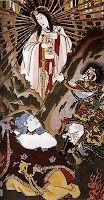Deities of July: Light and Dark
The Light, the Sun...
Amaterasu (Amaterasu-ōmikami, Ōhiru-menomuchi-no-kami )
 The goddess Amaterasu, is probably one of the most famous goddess of the Shinto Religion. She is depicted as a goddess of the sun, contrary to the traditional belief that the sun is a masculine "planet" and therefore associated with the god.
The goddess Amaterasu, is probably one of the most famous goddess of the Shinto Religion. She is depicted as a goddess of the sun, contrary to the traditional belief that the sun is a masculine "planet" and therefore associated with the god.The goddess, considered to be a direct link to the Imperial House of Japan and is one of the most important deity of the Shinto religion. Her name literally means " She who Illuminates the Heavens" celebrates her feast every July 17th and December 8th.
Said to be born from Izanagi, she is considered the Sun Goddess because of her warmth and compassion.Amaterasu is credited with inventing the cultivation of rice and wheat, use of silkworms, and weaving with a loom.
She is famously linked Amaterasu with Dainichi Nyorai, a central manifestation of the Buddha, whose name is literally "Great Sun Buddha". Thus Amaterasu is held as an divine Emanation of Buddha Vairocana.
Her most important shrine, the Grand Shrine of Ise, is in Ise in western Honshu. The shrine is torn down and rebuilt every 20 years. In that shrine she is represented as a mirror, one of the three Japanese imperial regalia. The Ise Shrine is said to be the home of Amaterasu. This shrine, however, is not open to the public.
She is celebrated every July 17 with street processions all over the country. Festivities on December 21, the winter solstice, celebrate her coming out of the cave.
DARKNESS and the UNDERWORLD
 SET also known as Seth, Sutekh or Seteh is an ancient god, who was originally the god of the desert, storms, and chaos.
SET also known as Seth, Sutekh or Seteh is an ancient god, who was originally the god of the desert, storms, and chaos.
An immensely powerful god, he was regarded as a chief god sharing the title "His Majesty" with Ra. Set formed part of the Ennead of Heliopolis, as a son of the earth (Geb) and sky (Nut), husband to the fertile land around the Nile (Nebt-het/Nephthys), and brother to death (Usir/Osiris), and (Aset/Isis, the wife of Osiris) and father of Anubis.
Regarded as the god of foreigners, Set is pictured out to be a red haired god which is not a natural attribute of Egyptians thus the title. He is also the lord of gazelles and donkeys which are creatures living on the desert's edge. He is also associated with sandstorms linking him to the Caanite storm deity, Baal.
One of the more famous stories about Set is his fight with Osiris and Horus, which was viewed as the fight for supremacy between the Upper and Lower Egypts each ruled by the respective gods. Scholars also said that this battle between Horus and Set is the constant war between the desert (Set) and the Nile (Horus).The demonization of Set was also viewed as unfortunate by some scholars since he is not really viewed as evil in the ancient texts.
Set was worshipped at the temples of Ombos (Nubt near Naqada) and Ombos (Nubt near Kom Ombo), at Oxyrhynchus in upper Egypt, and also in part of the Fayyum area. More specifically, Set was worshipped in the relatively large metropolitan (yet provincial) locale of Sepermeru, especially during the Rammeside Period. There, Seth was honored with an important temple called the "House of Seth, Lord of Sepermeru." One of the epithets of this town was "gateway to the desert," which fits well with Seth's role as a deity of the frontier regions of ancient Egypt. At Sepermeru, Set's temple-enclosure included a small secondary shrine called "The House of Seth, Powerful-Is-His-Mighty-Arm. His feast is celebrated 15th of July.
Pictures taken from www.Uchina.com and www.Wikipedia.org


Comments